Overview
Core exercises for older women are essential for building strength and stability, which significantly enhances their overall health and independence. The article supports this by detailing how these exercises improve balance, reduce pain, and increase mobility, backed by research showing their effectiveness in preventing falls and enhancing daily functioning among seniors.
Introduction
The journey toward enhanced well-being for older women begins with a fundamental yet often overlooked aspect of fitness: core strength. As the backbone of physical stability and balance, a strong core not only supports daily activities but also plays a pivotal role in preventing falls and injuries—issues that become increasingly critical with age.
Research underscores the transformative impact of core exercises, revealing improvements in pain management, mobility, and overall quality of life. By embracing core training, older women can reclaim their independence and vitality, paving the way for a healthier, more active lifestyle.
This article delves into the importance of core strength, effective exercises tailored for older adults, and the myriad benefits that come from prioritizing this essential component of fitness.
The Importance of Core Strength for Older Women
Core exercises for older women are not merely a fitness trend; they are a crucial element of health and well-being for women in their later years. Strong abdominal muscles support the spine, improve posture, and enhance balance, which are essential for performing daily activities such as bending, lifting, and maintaining stability. Research indicates that fundamental training can be particularly effective for individuals aged 65 and older, who are at an increased risk of falling.
A randomized controlled trial involving 31 elderly women with low back pain showed that those who participated in stability routines alongside conventional physiotherapy experienced significant improvements in pain levels, disability, and mobility functions. Specifically, the intervention group showed increased transverse abdominal muscle thickness, indicating enhanced overall stability. This research demonstrates that developing fundamental stability is essential for avoiding falls and injuries.
As women grow older, they frequently encounter difficulties such as muscle deterioration and reduced bone density, making the emphasis on fundamental workouts even more essential. By incorporating core exercises for older women into their routines, senior women can greatly improve their quality of life and sustain independence for a longer period. As Olivia Walters aptly states, 'Embracing these activities is not merely a recommendation but a pathway to a healthier, more active life.'
For further reference, the study can be found under PMCID PMC4242935 and PMID 25435680.
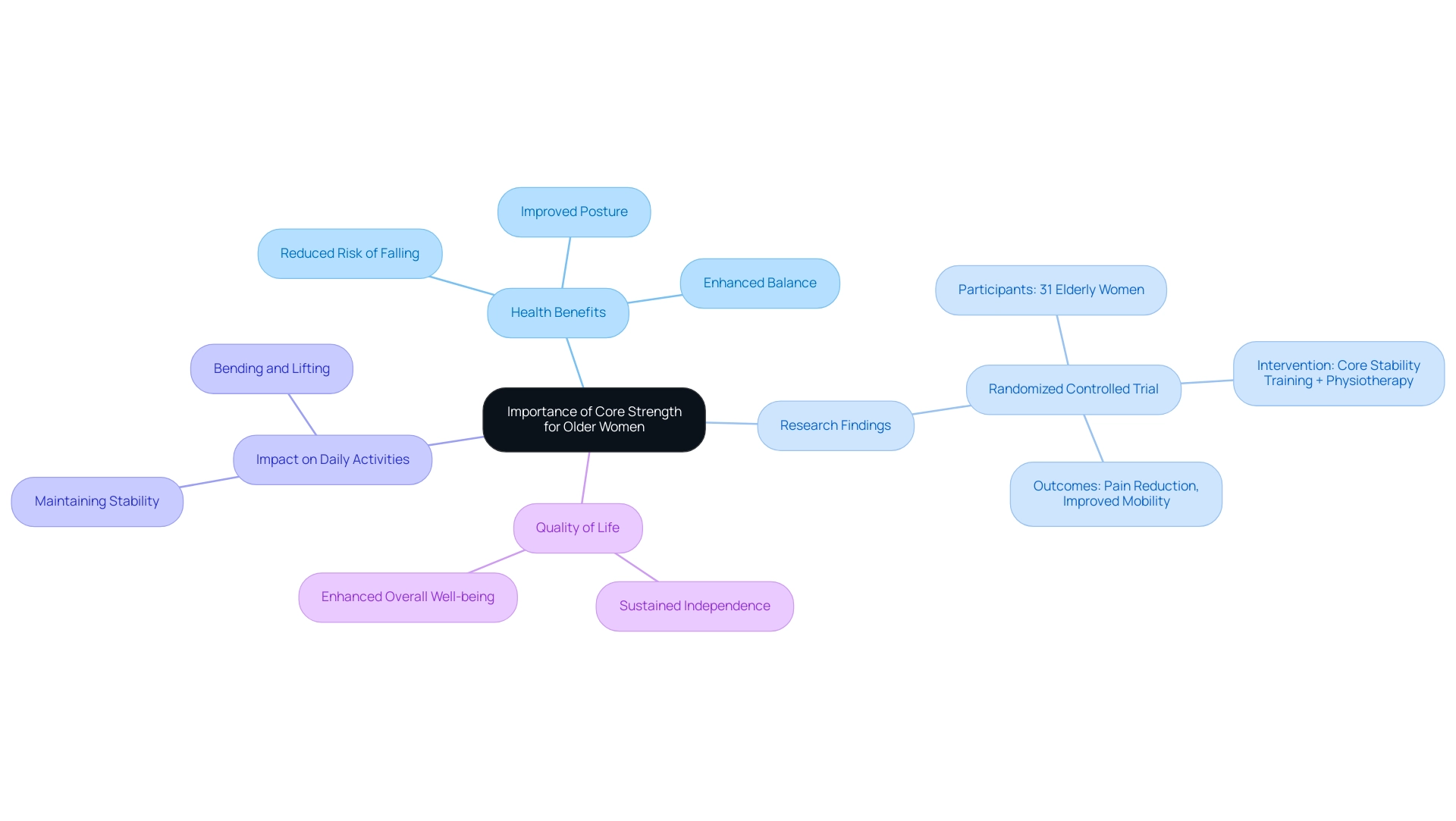
Effective Core Exercises for Building Strength and Stability
- Seated Leg Raises: Begin by sitting upright in a sturdy chair, ensuring your back is straight and supported. Gradually lift one leg off the ground, keeping it extended. Hold this position for a few seconds before lowering and switching to the other leg. This activity efficiently focuses on core exercises for older women, which are crucial for sustaining stability in older adults. Research indicates that following 16 training sessions, Tra thickness was enhanced, emphasizing the effectiveness of such activities in improving stability.
- Wall Sits: Position yourself with your back pressed against a wall. Gradually slide down into a seated position, ensuring your knees are bent at a 90-degree angle. Hold this stance for 10-30 seconds. Wall sits are among the best core exercises for older women, effectively building strength in the thighs and abdomen while significantly contributing to overall stability. According to findings from Lee HC et al., implementing a multifaceted fall prevention program, which includes fundamental activities, can significantly lower fall occurrence in senior individuals.
- Bird-Dog: Start on all fours, ensuring your hands are directly under your shoulders and your knees under your hips. Extend one arm forward while simultaneously extending the opposite leg back, maintaining a stable posture throughout. Hold this position for a few seconds before switching sides. This activity includes core exercises for older women that engage the whole midsection, enhancing stability and coordination. A systematic review on fundamental stability activities for individuals with non-specific low back pain suggests that such activities can effectively enhance the musculature providing support to the spine, which is essential for older adults.
- Bridge: Lie flat on your back with your knees bent and feet flat on the floor. Raise your hips towards the ceiling while squeezing your glutes and activating your abdominal muscles. Hold this elevated position for a moment before gently lowering back down. The bridge movement is one of the core exercises for older women that strengthens the lower back and abdomen, offering essential support for everyday tasks.
- Standing Side Leg Raises: Stand tall while holding onto a chair for balance. With a straight leg, lift one leg out to the side, then lower it back down. This activity not only strengthens the hips and midsection but also enhances balance, which is essential for fall prevention among seniors.
Integrating core exercises for older women into your routine can significantly improve physical function and lessen the risk of injuries. According to research, core exercises for older women have shown encouraging outcomes in improving strength and stability in senior populations, making them a vital part of fitness programs for the elderly. As mentioned by Aukuthota et al., understanding the principles behind these activities is crucial for maximizing their effectiveness.
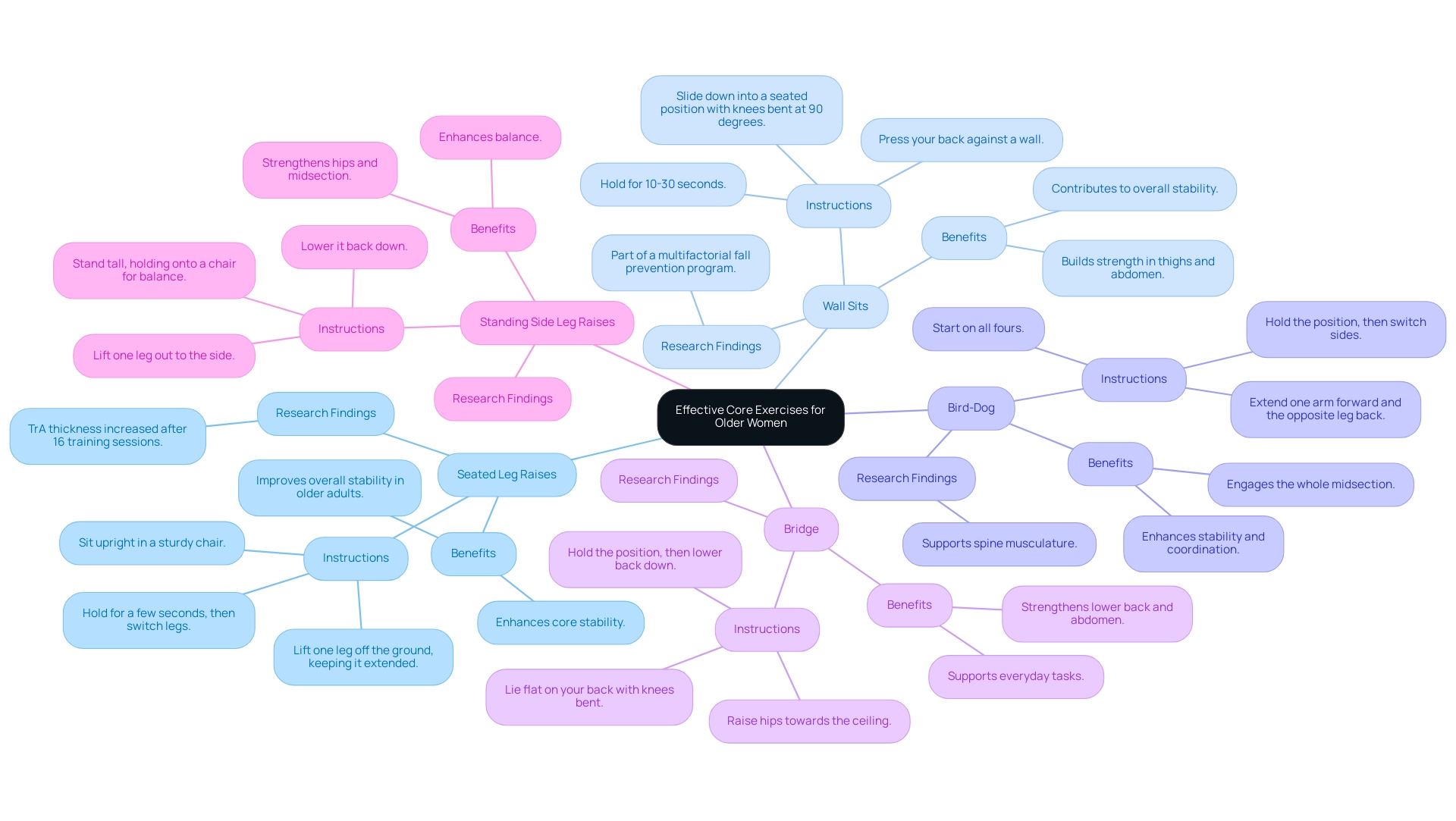
Benefits of Core Exercises for Older Women
The benefits of core exercises for older women are not only remarkable but crucial for enhancing their overall health and wellness. Consider the following benefits:
- Improved Balance: A robust core significantly enhances stability, effectively reducing the risk of falls—a critical concern given that 62.5% of older individuals in institutions experience low back pain. Case studies involving mobility function evaluations, such as the Timed Up and Go (TUG) test, have shown that central muscle training can result in noticeable advancements in balance and mobility.
- Reduced Pain: Strengthening the central muscles can play a pivotal role in alleviating back pain and discomfort, allowing mature women to experience a more comfortable daily life.
- Enhanced Mobility: With increased central stability, movement efficiency is heightened, making everyday tasks simpler and less taxing. Participants in the 10-meter walking test (10M-WT) showed significant improvements in their ability to navigate daily activities post-intervention.
- Increased Confidence: Improved physical ability and balance empower older women to participate in activities with renewed confidence, fostering a more active and engaging lifestyle.
- Boosted Mood: Regular participation in fundamental workouts releases endorphins, which elevate mood and help combat feelings of isolation or depression.
Dr. Kwon-Young Kang emphasizes that core exercises for older women should be considered as a therapeutic method to improve their overall well-being and as a fall prevention measure. This research, carried out in accordance with ethical standards and sanctioned by the ethics committee of the First Affiliated Hospital of Sun Yat-sen University, emphasizes the significance of fundamental fitness training. By promoting core exercises for older women, HR Benefits Managers can play a vital role in enhancing the quality of life for senior women, ultimately contributing to a healthier, more vibrant community.
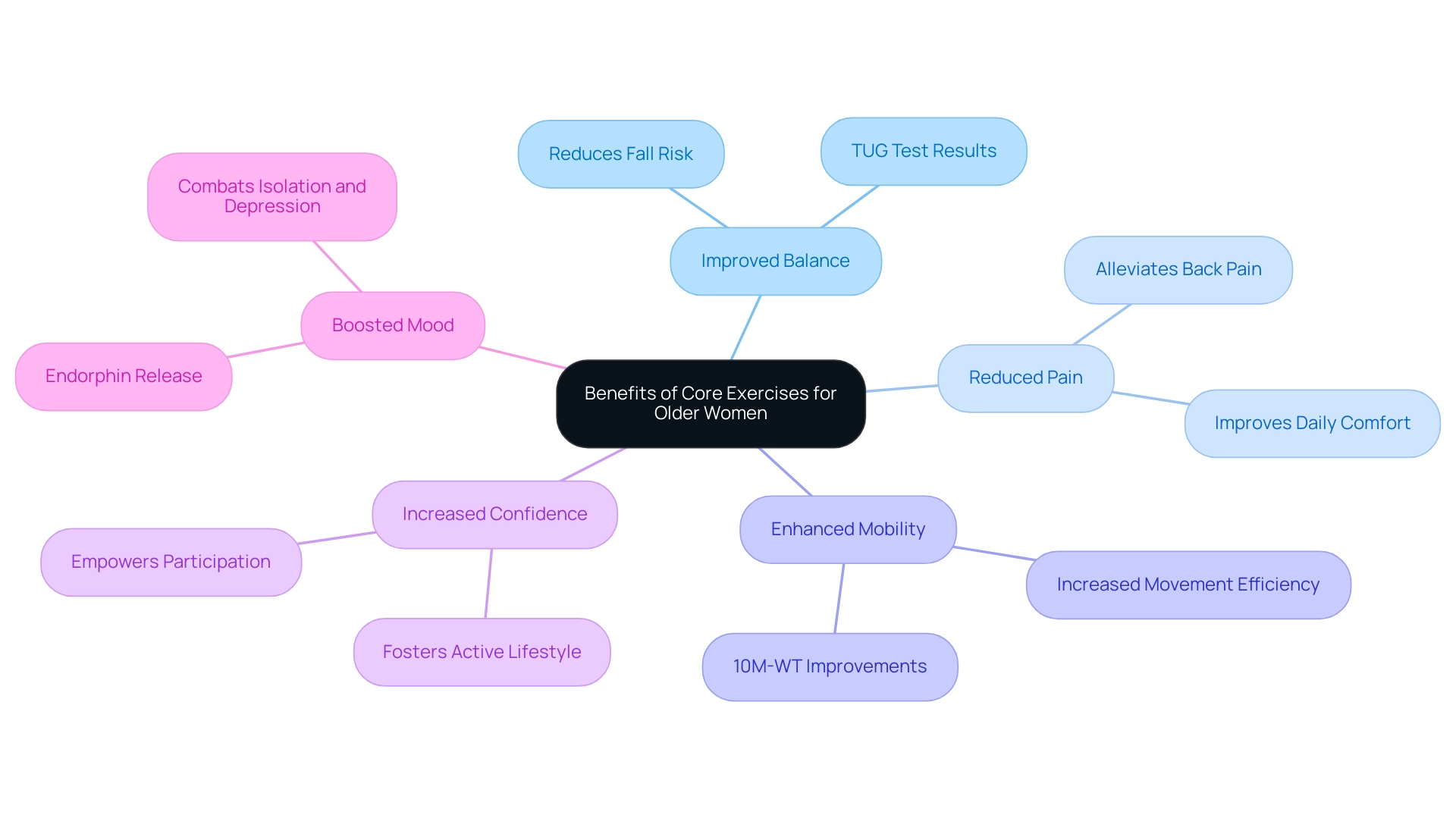
Safety Tips and Modifications for Core Exercises
- Listen to Your Body: Always be attuned to your body's signals during physical activity. If any movement causes discomfort or pain, it’s essential to stop and take a break. This self-awareness is crucial for maintaining a safe workout environment. As noted, 24.2% of adults age 18 and older met the Physical Activity Guidelines for both aerobic and muscle-strengthening activity, highlighting the importance of staying active while being mindful of personal limits.
- Use a Chair for Support: For standing activities, utilizing a sturdy chair can provide valuable support and balance. This simple modification can significantly reduce the risk of falls, ensuring a safer experience while exercising. The case study titled "Preventing Falls: Effective Strategies and Exercises for Seniors" outlines various strategies that can help in this regard.
- Modify Range of Motion: If a full range of motion feels challenging, it’s perfectly acceptable to perform activities with a limited range. For example, during wall sits, lower yourself only partway until you develop the necessary strength. This gradual approach helps build confidence and capability, reflecting the personalized attention provided by dedicated health coaches in corporate wellness programs.
- Take Breaks: Remember to allow adequate time for rest between workouts. This practice not only prevents overexertion but also enhances overall performance by giving your body the opportunity to recover, ultimately fostering a healthier and more productive team environment.
- Consult a Professional: Before starting any new fitness program, particularly if you have existing health conditions, it’s wise to consult with a healthcare provider or a certified fitness instructor. They can assist in customizing a program that meets your personal requirements, ensuring you engage in activities safely and effectively. As we recognize that "America is rapidly aging in a country built for the young," addressing these safety tips is more crucial than ever. By investing in your team's health through tailored wellness programs and utilizing our customized app, which offers personalized tracking and support, you're not only promoting well-being but also enhancing productivity and cognitive performance. Our services specifically address the unique challenges faced by senior adults in the workplace, ensuring that all team members can thrive.
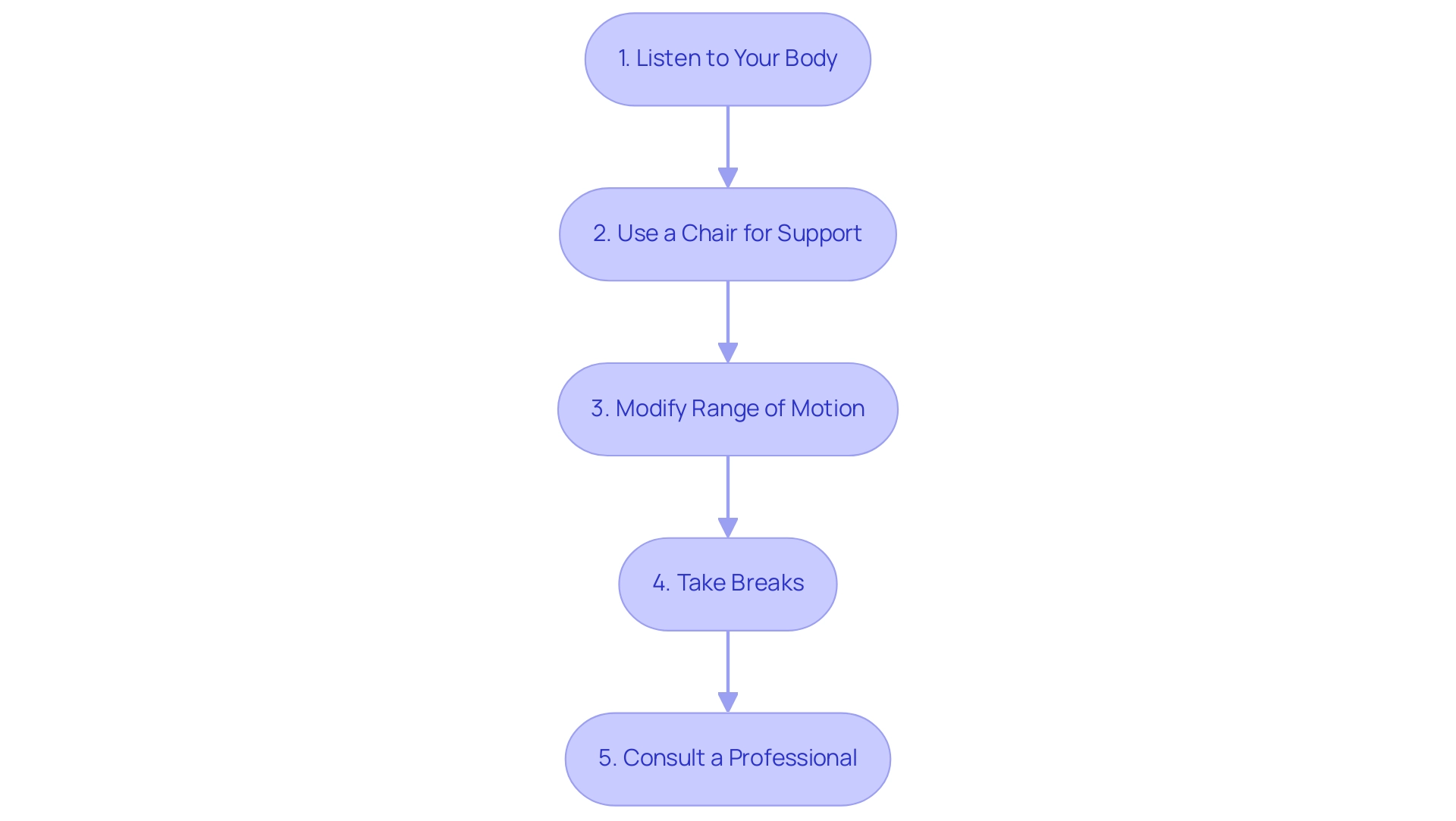
Building a Consistent Core Training Routine
- Set Realistic Goals: Begin with attainable objectives, such as engaging in fundamental workouts two to three times a week. This approach fosters a sense of accomplishment and paves the way for gradual improvement. Notably, adherence rates for program completion among older adults range from 65% to 86%, highlighting the importance of setting realistic expectations.
- Schedule Your Workouts: Treat your core training as a vital appointment by dedicating specific times each week for your workouts. Consistency is key, and establishing a routine can significantly enhance adherence, as evidenced by the systematic review which found that personal factors, such as fewer health conditions and better self-rated health, positively influence adherence rates.
- Track Progress: Keep a journal to record your workouts, how you feel, and any improvements. This practice not only serves as a motivational tool but also helps in recognizing patterns that contribute to success. The review emphasizes that tracking can lead to better outcomes in adherence to physical activity.
- Incorporate Variety: Keep your routine enjoyable by introducing new activities or modifying existing ones. Participating in diverse activities aids in maintaining interest and promotes continued involvement in essential training. As mentioned in the systematic review, adherence to activity programs is influenced by program characteristics, so variety is essential.
- Celebrate Milestones: Acknowledge every achievement, such as completing core exercises for older women, no matter how small. Honoring these milestones strengthens dedication and enthusiasm, guaranteeing that the path toward improved core health remains rewarding and uplifting for seniors. As highlighted by Picorelli et al., adherence to exercise programs for older people is influenced by personal factors, making it crucial to celebrate individual progress.
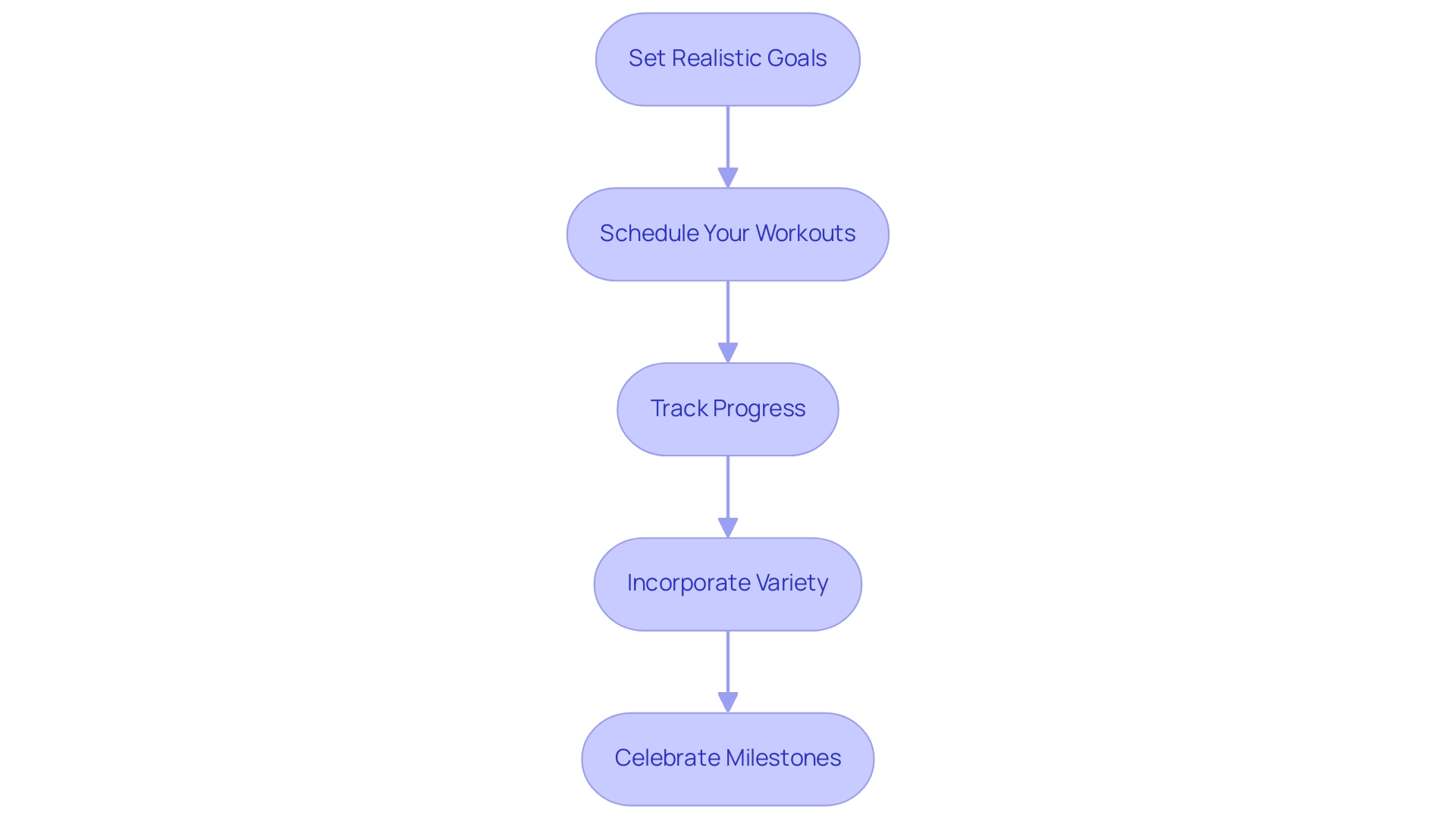
Conclusion
The emphasis on core strength for older women is not merely a fitness trend; it is an essential aspect of health and well-being that can significantly enhance quality of life. By understanding the importance of core exercises, older women can improve their balance, reduce pain, and increase mobility, ultimately leading to greater independence and confidence in their daily activities. The research presented showcases how targeted core training can mitigate the risks associated with aging, including falls and injuries.
Implementing effective core exercises such as:
- Seated leg raises
- Wall sits
- Bridges
can build stability and strength. Safety tips and modifications ensure that these exercises can be performed effectively, accommodating the unique needs of older adults. Furthermore, establishing a consistent training routine, setting realistic goals, and celebrating milestones fosters a sense of accomplishment and encourages ongoing participation.
In prioritizing core strength, older women can reclaim their vitality and engage more fully in life. It is crucial to advocate for these practices, not just for individual health but for the broader community, as healthier individuals contribute to a more vibrant society. Now is the time to take action and embrace the transformative power of core training for a healthier, more active future.
Frequently Asked Questions
Why are core exercises important for older women?
Core exercises are crucial for older women as they support the spine, improve posture, and enhance balance, which are essential for daily activities like bending, lifting, and maintaining stability.
What does research say about core exercises for older adults?
Research indicates that fundamental training can be particularly effective for individuals aged 65 and older, who are at an increased risk of falling. A study showed that elderly women who participated in stability routines alongside physiotherapy experienced significant improvements in pain levels, disability, and mobility functions.
What are some specific core exercises recommended for older women?
Recommended core exercises for older women include: 1. Seated Leg Raises: Lifting one leg while seated to improve stability. 2. Wall Sits: Sliding down a wall into a seated position to build strength in the thighs and abdomen. 3. Bird-Dog: Extending one arm and the opposite leg while on all fours to enhance stability and coordination. 4. Bridge: Lifting hips while lying on the back to strengthen the lower back and abdomen. 5. Standing Side Leg Raises: Lifting a leg to the side while holding onto a chair for balance to strengthen hips and improve balance.
How can core exercises affect the quality of life for senior women?
By incorporating core exercises into their routines, senior women can significantly improve their quality of life and sustain independence for a longer period, helping to counteract muscle deterioration and reduced bone density.
What are the benefits of integrating core exercises into a fitness routine for older adults?
Integrating core exercises can improve physical function, enhance strength and stability, and lessen the risk of injuries, making them a vital part of fitness programs for the elderly.

